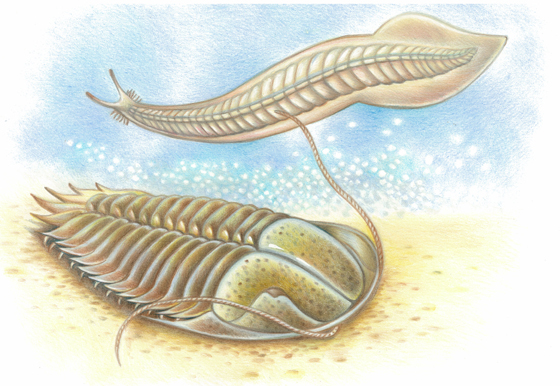
 |
 |
Pikaia & Olenoides
 Michelle Bakay after Graham Rosewarne & Colin Newman Burgess Shale Cambrian |
Pikaia gracilens is an important member of the Burgess Shale fauna. Pakaia possesses a stiff rod along its dorsal margin. The notochord like structure along with the paired muscle blocks suggests that Pikaia may be a chordate. The narrow anterior end is equipped with a pair of tentacles. The posterior end expands into a fin-like tail. This lancelet like organism probably swam like an eel. Specimens average 5 cm in length (Selden & Nudds, 2004, p. 26). The Burgess Shale gives paleontologists insight into the soft body parts of the Trilobite Olenoides. The cephalon (head) was equipped with three pairs of limbs and flexible antennae. Each throacic segment (mid-body sections) had pairs of biramous limbs. Unlike other trilobites Olenoides possessed antennae-like appendages at it rear end called caudal furca. The walking legs of Olenoides were equipped with sharp inward facing spines. These spines may have been used to shred food as it was passed forwards to the mouth. Olenoides was a predator that probably fed on a variety of worm-like organisms (Fortey, 2000, pp. 126-127).
Fortey, R. (2000). Trilobite: Eyewitness to Evolution. New York: Vintage Books. Selden P. & Nudds, J. (2004). Evolution of Fossil Ecosystems. Chicago: The University of Chicago Press. |










